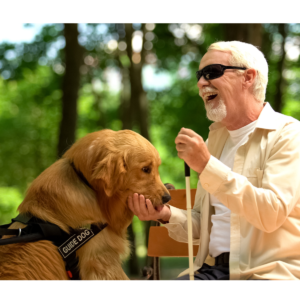Guide dogs are animals specially trained to help people with visual impairments move around safely and independently. Guide dogs are also known as assistance dogs for the blind or visually impaired.
Did you know?
The work of guide dogs begins at an early age. Puppies are raised by foster families, who teach them the basics of socialization and obedience. At the age of 12 to 18 months, guide dogs are placed in the care of professional trainers, who teach them the specific skills they will need to help their visually impaired owner.
The training of guide dogs is intensive and is done in stages. The first steps are to teach dogs basic commands such as “sit”, “down”, “stay”, “come”, “cowl”, “turn left”, “turn right”, etc. Dogs are also trained to move safely on sidewalks, cross roads, go up and down stairs, and avoid obstacles such as poles and benches.
Once dogs have mastered basic commands and safety skills, they begin more advanced training to help their handler navigate complex environments. Dogs are trained to identify obstacles such as doors, narrow passages and stairs using their sight, smell and sense of hearing. Dogs can also be trained to help their handler locate specific objects such as exit doors, mailboxes, and stores.
When guide dogs have completed their training, they are paired with a visually impaired handler. Dogs are trained to obey their master’s commands and to guide him safely through the environments they pass through together. Guide dogs are also trained to focus on their job, ignore distractions, and remain calm in stressful situations.
Guide dogs are very important animals for people with visual impairments, as they provide valuable assistance in moving around safely and independently. Guide dogs allow their handlers to focus on their daily activities and live a more independent life.
The main tasks that guide dogs perform:
- Navigation: Guide dogs are trained to recognize obstacles in the way and avoid or circumvent them. They are able to detect stairs, sidewalks, overhead obstacles, crosswalks and intersections.
- Maintaining direction: Guide dogs are trained to follow a path determined by their handler. They are able to focus on the route and maintain direction without being distracted by external stimuli.Stop Recognition: Guide dogs are trained to recognize and report transit stops, crosswalks, sidewalks, stairs and doorways.
- Heeding Audible Signals: Guide dogs are trained to respond to audible signals such as vehicle horns, fire alarms, and door bells. They must be able to interpret these signals and guide their master accordingly.
- Danger detection: Guide dogs are trained to detect dangerous situations and protect their owners. For example, they can warn their master if there is a vehicle approaching at high speed, if there is a slippery surface, or if a person is in their path.
- Assistance in daily activities: Guide dogs can help their handler with certain daily tasks, such as finding objects, opening doors or accessing public transport.
The main skills needed for guide dogs:
- Obedience: Guide dogs should be obedient and well trained to respond to commands from their handler and trainer. They must be able to walk on a leash without pulling, to stop on command and to follow verbal or gestural instructions precisely.
- Concentration: Guide dogs must be able to concentrate on their work despite external distractions, such as noises, smells, and other animals. They must be able to stay calm and attentive to guide their master safely.
- Orientation: Guide dogs must be able to orient themselves in their environment and recognize safe routes to guide their handler. They must be able to navigate different types of environments, including busy streets, intersections, and public places.
- Hazard Recognition: Guide dogs must be able to recognize potential hazards such as raised curbs, low obstacles, moving vehicles, and other obstacles in their path. They must be able to anticipate dangers and guide their master safely around them.
- Sociability: Guide dogs should be sociable and behave well in public. They must be comfortable with people, other animals, and the different social environments they will be exposed to. They must also be able to stay calm and relaxed in stressful situations.
- Self-confidence: Guide dogs must be confident and sure of themselves in order to be able to guide their master with confidence. They must be able to make independent decisions and act autonomously to ensure the safety of their master.
- Empathy: Guide dogs must be able to understand and respond to their handler’s emotional needs. They should be sensitive to their handler’s emotional cues and mood swings, and be able to comfort and soothe their handler in stressful situations.
There are several dog breeds that are commonly used as guide dogs.
These dogs are carefully bred for their intelligence, learning ability, obedience, calmness, and ability to work closely with their human partner.
- The Labrador Retriever: This breed is one of the most popular breeds for guide dogs due to their friendly nature, intelligence, and ability to adapt to a variety of situations. Labradors are also known for their excellent ability to work in a team and focus on the needs of their human partner.
- The Golden Retriever: Also known for its friendly nature and high intelligence, the Golden Retriever is a popular breed for guide dogs. They are also known for their gentleness and patience, which makes them excellent companions for people who are blind or have low vision.
- The German Shepherd: Although less common than Labradors and Golden Retrievers, the German Shepherd is also used as a guide dog due to their intelligence, loyalty, and ability to be trained for a variety of tasks. German Shepherds are often chosen for their size and strength, which can be beneficial in helping blind people get around safely.
- Australian Shepherd: This breed is less common as a guide dog, but is known for its intelligence, loyalty, and energy. Australian Shepherds can be trained to help blind people avoid obstacles and move around safely.
- Bernese Mountain Dog: Although less common as a guide dog, the Bernese Mountain Dog is a breed that is sometimes used for its size, strength and protective nature. They can be trained to help blind people navigate around obstacles and safely cross intersections.
It is important to note that the breed of the dog is not the only determining factor in the selection of a guide dog. The temperament, behavior and individual abilities of the dog are also considered when selecting and training a guide dog. Each dog is individually assessed to determine if they are suitable to become a guide dog and to work as a partner of a blind or visually impaired person. In conclusion, the health of a guide dog is essential so that it can effectively carry out its work of assistance with a blind or visually impaired person. In addition to the breed and the individual qualities of the dog, good nutrition is a key element in keeping the dog fit and healthy.
PRO TEAM offers a balanced diet appropriate to the specific needs of guide dogs in order to help maintain their health, energy level and ability to perform their duties optimally. Looking after the health and well-being of the guide dog is therefore an important aspect of their training and their work as a valuable assistant to people who are blind or partially sighted. Find PRO TEAM news on Facebook

